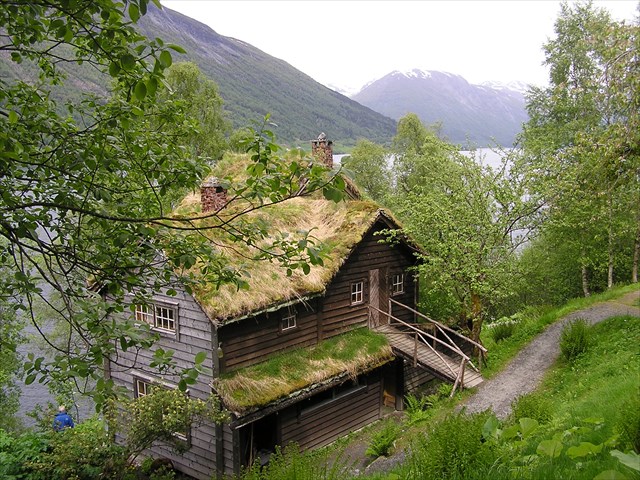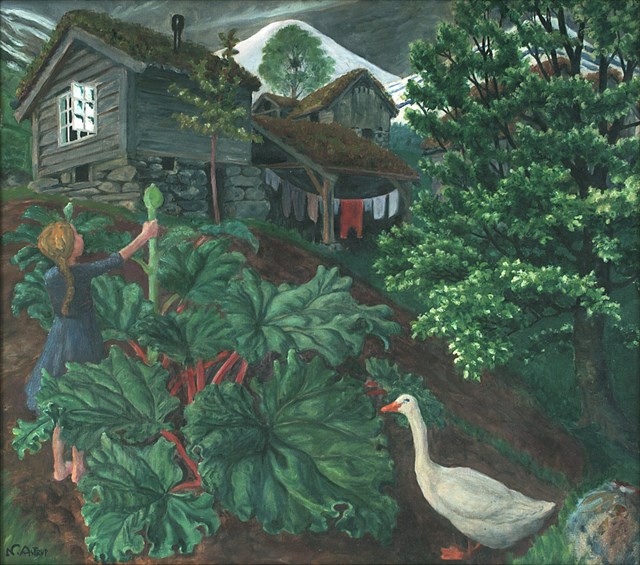Norsk
 Astruptunet er eit museum og eit tidlegare gardsbruk med namnet Sanddalsstrand på sørsida av Jølstravatnet ved Sanddal i Jølster. Det er kjent som kunstnarheim for målaren Nikolai Astrup (1880–1928), som bygde ut gardstunet og budde der i åra 1914–1928, altså dei siste 14 åra av livet sitt.
Astruptunet er eit museum og eit tidlegare gardsbruk med namnet Sanddalsstrand på sørsida av Jølstravatnet ved Sanddal i Jølster. Det er kjent som kunstnarheim for målaren Nikolai Astrup (1880–1928), som bygde ut gardstunet og budde der i åra 1914–1928, altså dei siste 14 åra av livet sitt.
Nikolai og Engel Astrup gifta seg i 1907. I 1912 flytta dei inn i nytt hus etter å ha kjøpt hustomt og jord på Myklebust. Her vart dei frålurt skøytet av den tidlegare grunneigaren og så dårleg behandla av bygdefolket at dei alt i 1914 ikkje såg anna utveg enn å flytte til Sanddalsstrand. Der fekk dei med lånte pengar og mykje strev etter kvart reparert gammalt og bygd ut tunet med større og fleire hus. Nokre av husa var gamle bygningar dei kjøpte og sette opp att. Det opphavlege huset, Gamlestova, har ei historie som går tilbake til 1700-talet. Dermed fekk tunet i løpet av fyrste halvdel av 1920-åra den bygningsmassen vi i dag kjenner som Astruptunet.
 Gardsbruket er halde slik det var då målaren levde. Mange av verka hans er stilte ut der, og det er ein liten kafé for dei som besøkjer det. Huset og tunet er avbilda i flere av måleria til Astrup, ofte saman med hagen, der Astrup mellom anna dyrka eple og rabarbra. I dag er Astruptunet ikkje berre ein kunstnarheim, men òg ein viktig del av livsverket til kunstnaren. Både i interiør og eksteriør kan ein sjå den kjærleiken Astrup hadde til landskapet og plassen. Fjøsen rommar eit moderne brannsikkert galleri der publikum kan sjå ei unik samling trykkplater og bilete.
Gardsbruket er halde slik det var då målaren levde. Mange av verka hans er stilte ut der, og det er ein liten kafé for dei som besøkjer det. Huset og tunet er avbilda i flere av måleria til Astrup, ofte saman med hagen, der Astrup mellom anna dyrka eple og rabarbra. I dag er Astruptunet ikkje berre ein kunstnarheim, men òg ein viktig del av livsverket til kunstnaren. Både i interiør og eksteriør kan ein sjå den kjærleiken Astrup hadde til landskapet og plassen. Fjøsen rommar eit moderne brannsikkert galleri der publikum kan sjå ei unik samling trykkplater og bilete.
I 1964 kjøpte Jølster kommune eigedommen. Engel Astrup budde då framleis på garden, men ho døydde året etter. Løa vart riven og bygd opp att til eit galleri, men med same utsjånad som den gamle løa. Jonsokhelga 1986 vart så ein ny galleribygning innvigd. I 2004 vart museet konsolidert med Sogn og Fjordane kunstmuseum, og i 2009 danna ein eininga Musea i Sogn og Fjordane. Det har vore snakk om å byggje eit servicebygg til museet, men det er vanskeleg å plassere eit slikt bygg i det særmerkte kulturlandskapet.
Om Nikolai Astrup
Målaren, grafikaren og teiknaren Nikolai Astrup vart fødd i Kalvåg i 1880. Familien flytta til Prestegarden på Ålhus i Jølster i 1883. Etter å ha fått undervisning av Harriet Backer og Christian Krohg gjorde han studiereiser til mellom anna Frankrike, Tyskland, Italia og Algerie. Dermed fekk han kjennskap til både norske og internasjonale straumdrag innanfor kunsten. Dei aller fleste motiva hans er henta frå Jølster, og Nikolai Astrup har i ettertid vorte ståande som ein av dei mest norske av dei nasjonale kunstnarane våre.
English
 Astruptunet is a museum and a former farm named Sanddalsstrand on the southern side of the lake Jølstravatnet, at Sanddal in the Municipality of Jølster. It is known as an artist home of painter Nikolai Astrup (1880-1928), who developed the farm and lived there from 1914 to 1928, i.e. the last 14 years of his life.
Astruptunet is a museum and a former farm named Sanddalsstrand on the southern side of the lake Jølstravatnet, at Sanddal in the Municipality of Jølster. It is known as an artist home of painter Nikolai Astrup (1880-1928), who developed the farm and lived there from 1914 to 1928, i.e. the last 14 years of his life.
Nikolai and Engel Astrup were married in 1907. In 1912 they moved into a new house after buying a building lot and land at Myklebust. Here, the former landowner tricked them with the conveyance and they were so badly treated by the neighbours that they already in 1914 did not see any other solutions than to move to Sanddalsstrand. There, borrowed money and a lot of hard work eventually helped them repair old buildings and develop the farm with more and larger houses. Some of the houses were old buildings they bought and erected anew. The original house, Gamlestova, has a history that goes back to the 1700s. Thus was it that the farm during the first half of the 1920s took the shape that we today know as Astruptunet.
 The farm is held as it was when the painter lived. Many of his works are exhibited there, and there is a small cafe for the visitors. The house and yard are depicted in several paintings by Astrup, often together with the garden, where Astrup among other things grew apples and rhubarb. Today, Astruptunet does not only showcase an artist home, but also an important part of the life work of the artist. Both through the interior and exterior, one can see the love that Astrup had to the landscape and this place in particular. The barn houses a modern fireproof gallery where the public can see a unique collection of print plates and paintings.
The farm is held as it was when the painter lived. Many of his works are exhibited there, and there is a small cafe for the visitors. The house and yard are depicted in several paintings by Astrup, often together with the garden, where Astrup among other things grew apples and rhubarb. Today, Astruptunet does not only showcase an artist home, but also an important part of the life work of the artist. Both through the interior and exterior, one can see the love that Astrup had to the landscape and this place in particular. The barn houses a modern fireproof gallery where the public can see a unique collection of print plates and paintings.
In 1964, the Municipality of Jølster bought the property. Engel Astrup was still living at the farm at this point, but she died the following year. The barn was torn down and rebuilt as a gallery, but with the same appearance as the old barn. At Midsummer 1986, a new gallery building was opened. In 2004, the museum consolidated with Sogn og Fjordane Art Museum, and in 2009, the unit Museums of Sogn og Fjordane was formed. There have been loose plans of building a service building for the museum, but it is difficult to place such a building in the characteristic landscape.
About Nikolai Astrup
The painter, graphic artist and sketch artist Nikolai Astrup was born in Kalvåg, Bremanger in 1880. The family moved to the vicarage at Ålhus, Jølster in 1883. After having been apprenticed by Harriet Backer and Christian Krohg, he made study trips to France, Germany, Italy, Algeria etc. Thus, he acquired knowledge of both Norwegian and international trends within the arts. The majority of his motives are taken from Jølster, and Nikolai Astrup has become one of the most Norwegian of the country’s nationally acclaimed artists.